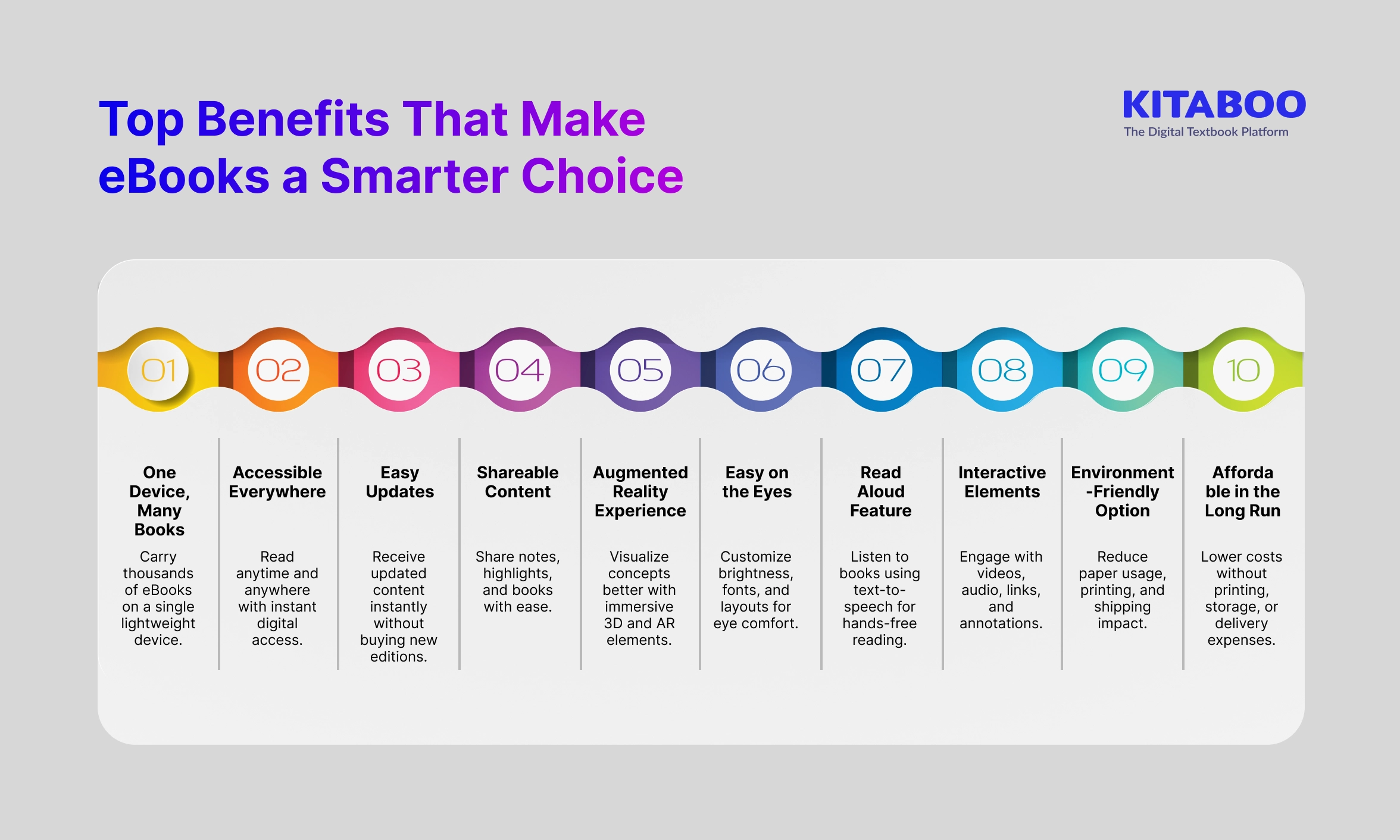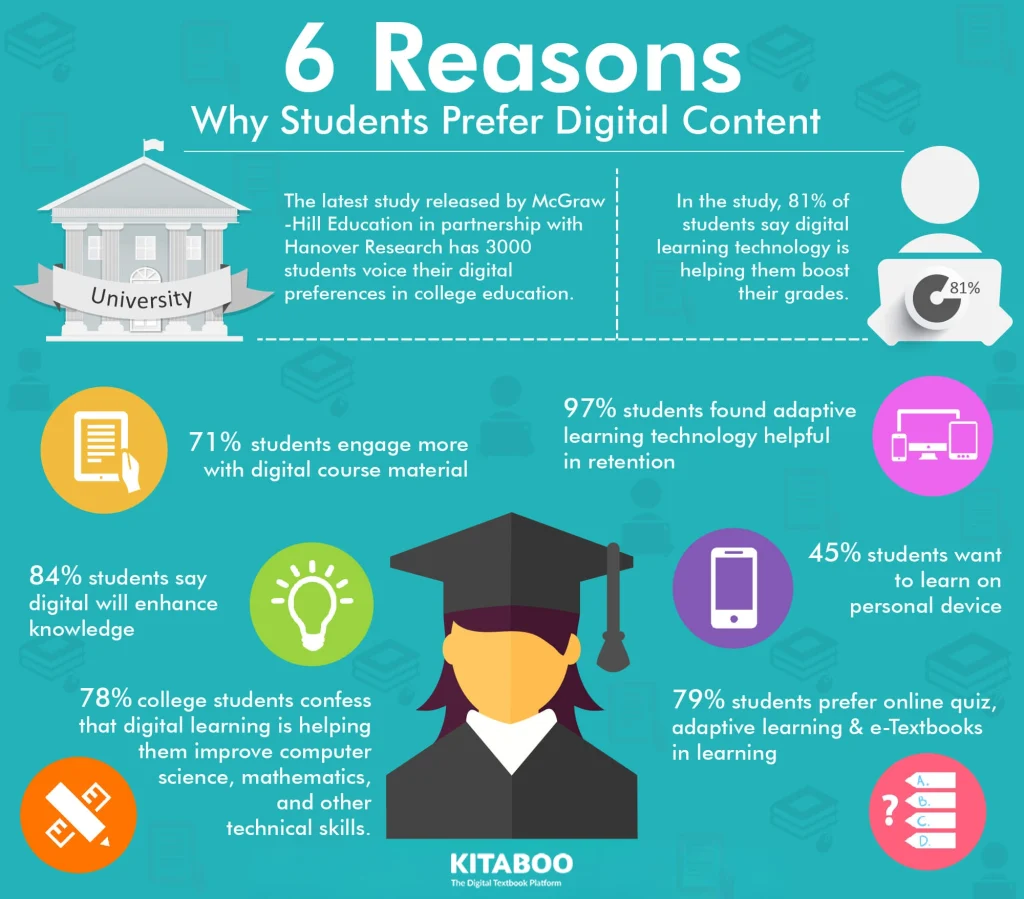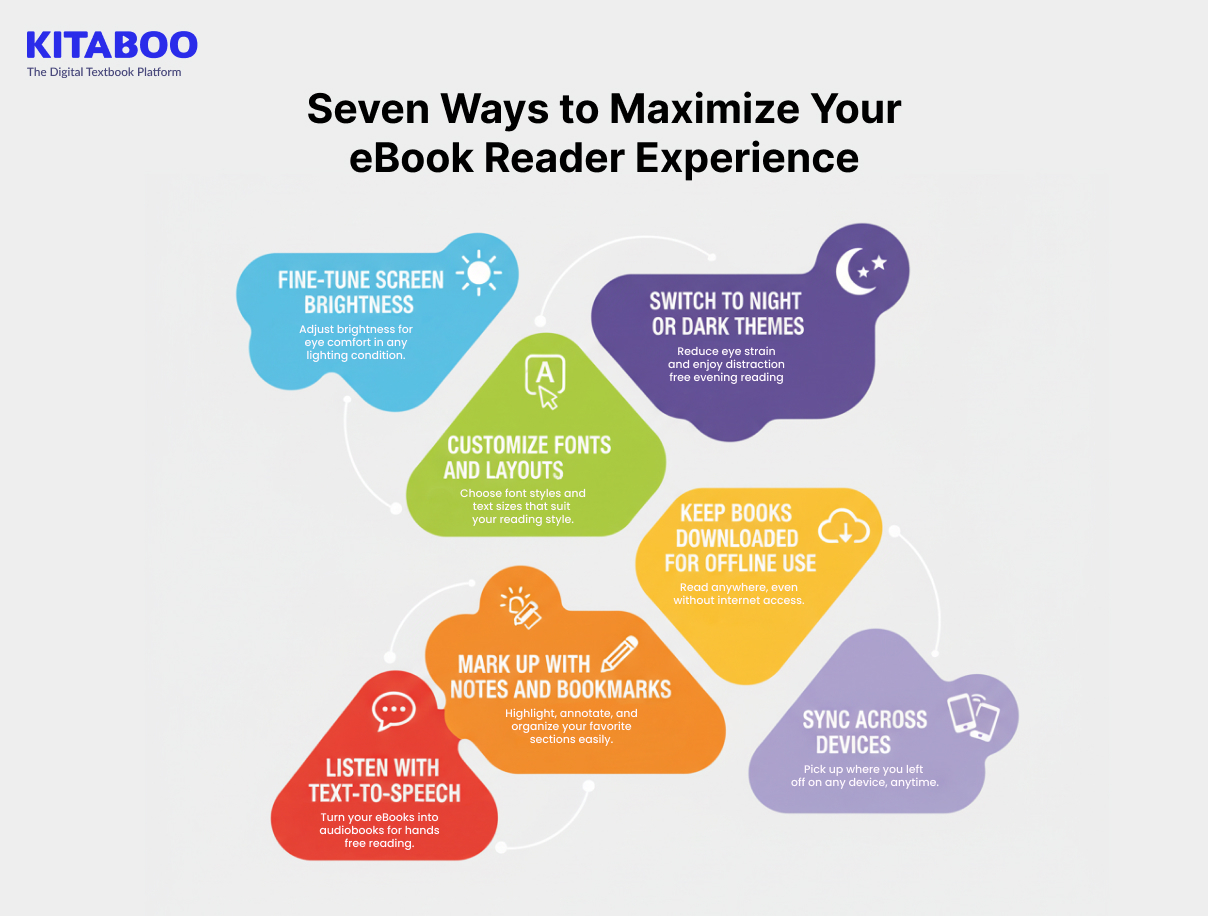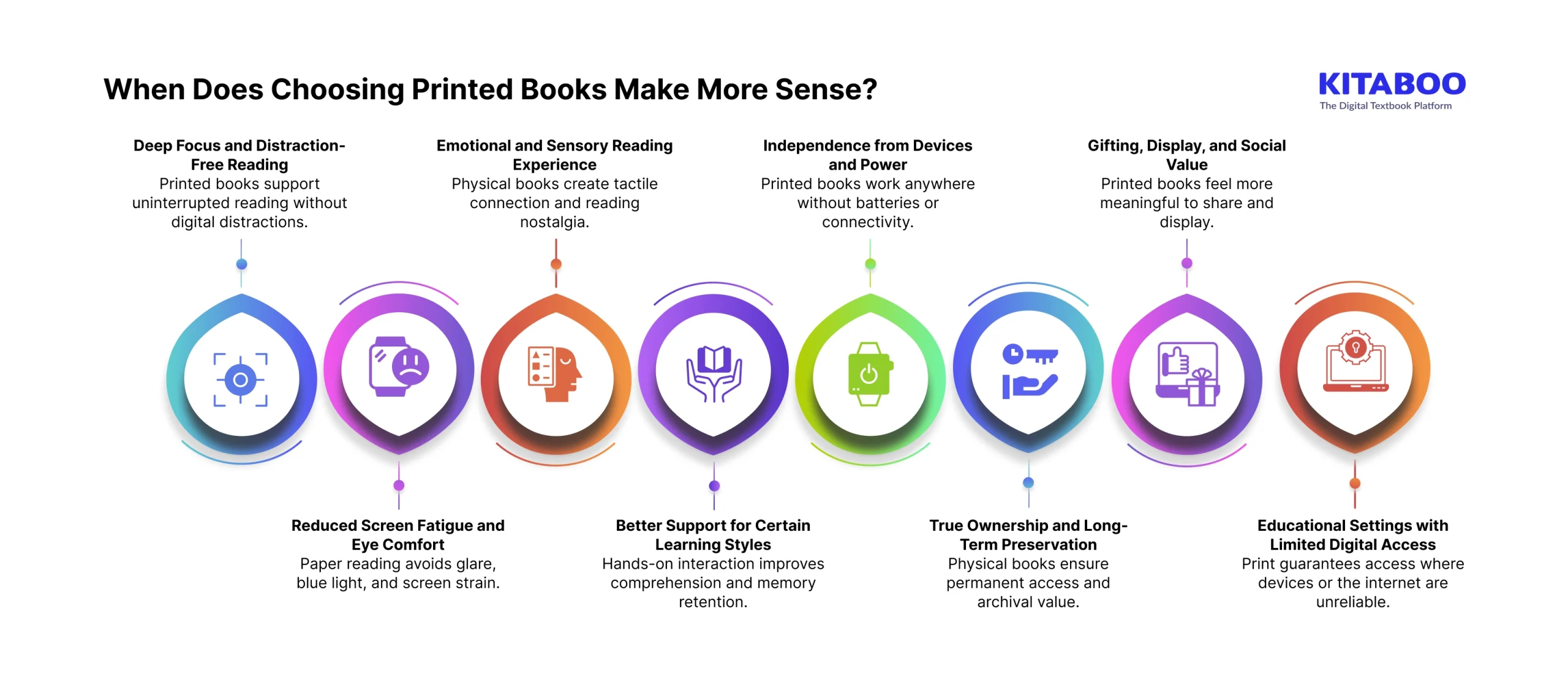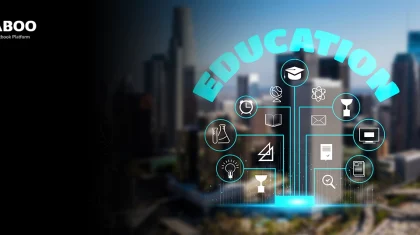
Top 10 Advantages of eBooks Over Printed Books (2026)
Summarize this blog with your favorite AI:
Advantages of eBooks Over Printed Books – TL;DR
eBooks are reshaping how people read, learn, and consume content today. Choosing an eBook over printed books offers portability, instant access, and flexible reading experiences. Readers can store entire libraries on one device and read anytime.
Beyond convenience, eBooks support interactivity, accessibility, and long-term cost savings. Features like multimedia, read-aloud, and content updates enhance engagement. These advantages explain the growing preference for digital reading formats.
Here’s a quick snapshot of their key advantages over printed books:
| Advantages of eBooks | Why Does It Matter? |
|---|---|
| All Your Books in One Device | Store and access thousands of titles anywhere. |
| Read Anytime, Anywhere | Download books and enjoy offline reading on the go. |
| Instant Content Updates | Always get the latest editions without extra cost. |
| Easy Sharing Options | Share highlights and books with friends or teams. |
| Immersive AR Experiences | Explore 3D visuals to understand concepts better. |
| Custom Reading Comfort | Adjust brightness, fonts, and layouts to your liking. |
| Hands-Free Reading | Listen to books with read-aloud and text-to-speech. |
| Engaging Multimedia Content | Access videos, audio clips, and interactive elements. |
| Eco-Friendly Choice | Reduce paper use, printing, and shipping emissions. |
| Cost-Effective Option | Save money with no printing or delivery expenses. |
eBooks are no longer a secondary alternative to traditional reading. Choosing an eBook over printed books reflects evolving reader behavior and digital consumption patterns. Readers expect instant access, flexibility, and richer engagement from content today.
Educational, professional, and leisure reading needs are also changing rapidly. An eBook over printed books aligns better with modern learning, mobility, and content updates. It delivers functional advantages that printed formats struggle to match.
- An eBook over printed books allows readers to carry thousands of titles on one device.
- An eBook over printed books enables instant access without visiting stores or waiting for deliveries.
- An eBook over printed books supports interactive learning through multimedia and smart features.
- An eBook over printed books offers better accessibility for diverse reading needs.
- An eBook over printed books reduces long-term costs for readers and institutions.
- An eBook over printed books supports sustainability by minimizing paper and shipping usage.
Printed books vs digital books is an age-old debate. There are and will be people who support printed books as well as electronic books or eBooks. With the rising number of tech-savvy people, every service provider is digitizing their services so as to cater to this large community of digital users.
Publishing is also one such industry which has entered the digital era to make reading more convenient for people.
Schools and corporate organizations are increasingly moving towards eBooks for training purposes because eBooks are better equipped to provide an engaging learning and reading experience to users.
Digital publishing has been looming large over print versions since quite some time now. But print publishers are still standing strong despite the onslaught of digital devices and their seemingly growing popularity.
If you compare the two, you would find that although printed hardcover books are much loved for their authenticity and the feel of holding an actual book, eBooks are more functional and fare far better in terms of ease of carrying. Let us see some of the advantages that eBooks have over the traditional printed books.
Table of Contents
I. Top 10 Advantages of eBooks over Printed Books
- One Device, Many Books
- Accessible Everywhere
- Easy Updates
- Shareable Content
- Augmented Reality Experience
- Easy on the Eyes
- Read Aloud Feature
- Interactive Elements
- Environment Friendly Option
- Affordable in the Long Run
II. eBook vs Print Book: Feature Comparison
III. How to Get the Most from Your eBook Reader?
- Adjust Brightness for Comfort
- Use Custom Fonts and Sizes
- Explore Night and Dark Modes
- Download Books for Offline Reading
- Highlight, Bookmark, and Annotate
- Use Read-Aloud or Text-to-Speech Features
- Take Advantage of Cloud Syncing
IV. When are Printed Books Still Better than eBooks?
V. Conclusion
VI. FAQs
Top 10 Advantages of eBooks over Printed Books
eBooks have evolved beyond simple digital replicas of printed books. They now deliver smarter, more flexible reading experiences. Choosing an eBook over printed books supports modern reading habits and digital lifestyles. Readers expect instant access, portability, and personalization today.
An eBook over printed books enables interactive learning and continuous content updates. It also reduces long-term costs and improves accessibility. These advantages explain why eBooks continue to gain preference across industries.
1. One Device, Many Books:
eBooks are portable and lightweight, making it easy to carry around. Instead of carrying multiple bulky books, one eBook reader can hold thousands of eBooks. It saves a lot of space- in your home and in your bag. One doesn’t have to worry about the storage limit.
Also read – 9 Best Cross-Platform eBook Readers
A single device is enough to read any number of books you want. Students benefit the most out of it as they do not have to carry a bag full of books every day. It allows the user to store plenty of books on the device, way more than anyone can read in their lifetime.
This shows one of the strongest eBook portability advantages for students, travelers, and busy readers. For example, a single Kindle or tablet can store an entire library, making it easier to study or read anywhere.
2. Accessible Everywhere:
eBooks can be downloaded and stored for later use. One can carry the eBook around and read them whenever they want. Students and employees can go through the learning material while at home and even while travelling. It is convenient for people on the go. Some eReaders come with the option of offline accessibility, allowing people to use it even in the absence of an internet connection.
Unlike printed books which have to be ordered or purchased from the bookstore, with time lost in waiting for delivery or travelling to the bookstore; readers can easily access any eBook anytime and anywhere.
This convenience highlights key eBook vs print book benefits for modern readers. For example, quick downloads and offline access make eBooks perfect for travel, study sessions, or work commutes.
Guide:
How to Build an eBook Store
3. Easy Updates:
The contents on the eBooks are mostly cloud-based, meaning it can be updated any time. Authors and publishers can always add the up-to-date information, providing users with the latest digital content. This saves reprinting costs and the time involved in the process.
This feature shows why to choose eBooks over printed copies that quickly become outdated. For example, students can receive updated textbooks instantly, avoiding the need to buy new editions.
4. Shareable Content:
You can share the eBook contents with multiple users. The social feature on the ebook allows sharing and liking of content, which is not possible with printed books.
You might share a printed book with one person at a time, but an eBook can be shared with many people at once. Students and employees can use this feature to collaborate with their peers.
This is one of the key advantages of eBooks over printed books for group learning and teamwork. For example, study groups can share notes instantly, making collaboration faster and more effective.
5. Augmented Reality Experience:
Augmented reality has taken the eBook experience to a whole new level. Texts and images can now be embedded with an augmented three-dimensional visual which pops up on the user’s screen. Readers can view a computer-generated 3D model of the image, which makes reading and learning a much more immersive experience.
The user only has to point the device at the image or text, and an enhanced version of the image will be displayed on their screen.
Many educational institutes and organizations are adopting this technology into their eBooks to enhance user experience.
These interactive eBook features make complex concepts easier to understand through visuals. For example, a medical student can study 3D anatomy models right from their eBook reader. This will enhance comprehension, engagement and learning outcomes.
Also read: How augmented reality can transform the classroom?
6. Easy on the Eyes:
eReaders these days come with features where you can adjust the brightness of the screen according to the time of the day and depending upon your preferences.
Many eReaders even have read in the dark feature, with lights that won’t strain your eyes, and neither would they disturb others around you. Users can even change the fonts of the text. They can increase or decrease the size of the font. Basically, eBooks ensure that your eyes are taken care of.
These settings highlight eBook vs print book benefits for readers who enjoy long sessions. For instance, adjustable brightness and font sizes make bedtime reading comfortable without extra lamps.
7. Read Aloud Feature:
eBooks have been designed with text to speech or read aloud features. This allows people to listen to the eBooks if they are too busy to read it, for example, while driving, or while doing some chores.
This feature is also helpful for children and adults with a learning disability or with visual impairment. It is also useful to help the user understand how a particular word is pronounced.
This is another reason why to choose eBooks for accessibility and convenience. For example, commuters can listen to audiobooks during travel, turning idle time into learning time.
Click on this exciting infographic showing 6 Reasons why Students Prefer Digital Content.
8. Interactive Elements:
Including interactive features in an eBook makes the reading experience a more engaging one. eBooks can be embedded with audio and videos. External links can be included to offer additional information.
The user can even bookmark a certain page or find a word in a quick and effortless way. It also allows users to make annotations. There are multiple such interactive features which can be included in order to enhance the overall reading experience.
These interactive eBook features create a richer learning environment than static printed pages. For instance, embedded videos or quizzes can help students grasp concepts faster and stay engaged.
Also read: 9 Benefits of Interactive eBooks
Here’s a video with an example of an ebook created with KITABOO the digital publishing platform, with multimedia enhancements, several interactive elements and features like read aloud.
9. eBooks are Environment-friendly:
They totally eliminate the paper printing process, saving printing cost for the publishers. Approximately 2.2 million books are published each year, using around 3 million trees.
If these paper printed books were to be replaced with a digital book, it could save all those trees from being chopped down. Apart from cutting trees, it also adds to the carbon footprint by transporting the raw materials, production process in the mill, and the final shipping.
All these processes can be eliminated with the help of eBooks.
While eBooks reduce paper use, printing, and shipping emissions, they are not impact-free. Devices require materials, manufacturing, and energy for charging.
However, one device can replace hundreds of printed books over its lifetime, reducing overall resource consumption including shipping overheads.
Thus, eBooks are better for the environment as a whole.
Guide:
Know How to Create an Interactive eBook
10. Affordable in the Long Run:
Some people might feel that since it’s a new technology and new device, the cost obviously would be higher than that of printed books. But, its quite the opposite. eBooks cost much less than printed books. Because there’s not much of pre-production involved like that in printed books.
No paperback covers, no paper printing, no packaging cost, no shipping. So eventually it becomes much cheaper than a printed book. So instead of spending on printed books, one can actually save money by investing in eBooks. eBooks are hence easy on the pockets.
eBooks have a lot more to offer than their printed counterparts. Unlike printed books, eBooks allows users to interact with the content. In a printed book, the maximum a user can do is mark pages or highlight texts.
But with eBooks, one can do much more, they can customize it as per their convenience, search for words they don’t understand, listen to the audiobook, watch videos and much more.
With augmented reality and interactivities, eBooks already have an upper hand when it comes to user engagement. eBooks are also cost-effective, not only for the publisher but also for the user. Print books definitely have a traditional value to it, but eBooks are something which will completely transform the reading and learning experience in the near future.
eBook vs Print Book: Feature Comparison
Choosing between eBooks and printed books often depends on convenience and features. The advantages of eBooks over printed books go beyond portability and include easy updates.
If you wonder why to choose eBooks, this table shows the main eBook vs print book benefits for today’s readers.
| Feature | eBook | Printed Book |
|---|---|---|
| Portability | Thousands of books in one lightweight device. | Bulky, requires carrying multiple books. |
| Accessibility | Instant downloads, read anytime, anywhere. | Requires purchase or delivery from a store. |
| Updates | Easy to update content digitally. | Requires reprinting for every new edition. |
| Interactivity | Videos, audio, AR, and interactive ebook features enhance engagement. | Limited to static text and images. |
| Environmental Impact | No paper, eco-friendly alternative. | Requires paper, printing, and shipping. |
| Cost | Affordable in the long run. | Higher costs due to printing and distribution. |
| Customization | Adjustable fonts, themes, read-aloud features. | Fixed layout and design. |
How to Get the Most from Your eBook Reader?
An eBook reader offers much more than a digital library. Knowing its features helps you read smarter. These tips highlight the advantages of eBooks over printed books and help you get more from your eBook reader.
1. Adjust Brightness for Comfort
Most eBook readers allow brightness control for different environments. Lower brightness in dim light to reduce strain and increase it in sunlight for clarity.
For example, the adaptive front light of an eBook reader adjusts automatically. This feature makes long reading sessions more enjoyable, showing eBook portability advantages for travelers and students.
2. Use Custom Fonts and Sizes
Change font styles and text sizes to match your comfort level. Larger text helps during long study sessions, while smaller text fits more on each page.
Some platforms also offer fonts for dyslexic readers. This customization is a clear reason why to choose eBooks over traditional books.
3. Explore Night and Dark Modes
Many devices offer night or dark modes for evening reading. This keeps your eyes comfortable and avoids disturbing others.
Combined with brightness settings, these modes make reading possible anywhere. They highlight key eBook vs print book benefits in terms of comfort.
4. Download Books for Offline Reading
Plan ahead and download eBooks before travel or commutes. This ensures access even without an internet connection.
Many readers prefer this for long flights or outdoor trips. Offline access is one of the strongest eBook portability advantages.
5. Highlight, Bookmark, and Annotate
Most eBook readers allow highlights, bookmarks, and notes. These tools are essential for students, researchers, and professionals.
They make revisiting key points simple and organized. Printed books can’t match these interactive eBook features that enhance learning and retention.
6. Use Read-Aloud or Text-to-Speech Features
If your eBook reader supports read-aloud, use it while driving or exercising. It helps visually impaired readers and supports multitasking.
Audio features also make studying easier, proving the advantages of eBooks over printed books for accessibility.
7. Take Advantage of Cloud Syncing
Cloud syncing lets you switch devices seamlessly. Start reading on a tablet at home and continue on your phone outside.
This convenience is a strong reason why to choose eBooks in today’s busy lifestyle. Syncing makes every book instantly available.
With these tips, your eBook reader becomes more than a device. It becomes a tool for comfort, efficiency, and a personalized reading journey.
When are Printed Books Still Better than eBooks?
The debate between digital and print formats is not absolute. Choosing an eBook over printed books is practical in many situations. However, printed books still hold advantages in specific contexts.
Reader intent, environment, and comfort strongly influence format preference. Understanding these factors ensures better reading outcomes. Even as digital adoption grows, print remains relevant.
1. Deep Focus and Distraction-Free Reading
Printed books support truly distraction-free reading experiences. There are no screen-based alerts or notifications. This helps readers maintain long-term concentration. Many readers experience deeper immersion with physical pages.
Academic and literary reading often benefit from this focus. The physical act of page turning reinforces attention. This is where eBook over printed books may not suit every reader.
2. Reduced Screen Fatigue and Eye Comfort
Prolonged screen exposure causes eye strain for many readers. Printed books eliminate glare and blue-light concerns completely. Readers working long hours on devices prefer print afterward.
This makes print ideal for extended reading sessions. Eye comfort improves reading endurance significantly. In these cases, an eBook over printed books may feel tiring.
3. Emotional and Sensory Reading Experience
Printed books provide a tactile reading experience. Paper texture and book weight create emotional attachment. Many readers associate print with nostalgia and personal memories. This enhances reading enjoyment and satisfaction.
Digital formats lack this sensory depth currently. Emotional connection remains a strong reason against choosing an eBook over printed books.
4. Better Support for Certain Learning Styles
Some learners absorb information better through physical interaction. Highlighting pages and flipping chapters aid spatial memory. Printed books help readers recall the location of any information.
This benefits complex subjects requiring deep comprehension. Hands-on learning styles often prefer print. In such cases, an eBook over printed books may reduce retention.
5. Independence from Devices and Power
Printed books operate without batteries or software. They remain accessible during power outages or travel. This reliability matters in low-connectivity environments.
Readers face no device compatibility issues. Printed books ensure uninterrupted access anywhere. This independence challenges the convenience of an eBook over printed books.
6. True Ownership and Long-Term Preservation
Printed books offer permanent ownership without licensing limits. Content cannot be altered or revoked digitally. Physical books last for decades with proper care.
Libraries value print for archival reliability. Some editions gain historical significance. Digital formats rarely match this permanence offered by an eBook over printed books.
7. Gifting, Display, and Social Value
Printed books work better as meaningful gifts. Signed copies hold sentimental importance. Physical books are easier to display and share.
They encourage social connection among readers. Many readers bond over shared physical books. This social aspect remains stronger than an eBook over printed books.
8. Educational Settings with Limited Digital Access
While the benefits of using eBooks in education are plenty, not all institutions have reliable digital infrastructure. Printed books ensure equal access for all learners. They remove dependency on devices and software updates.
This consistency supports uninterrupted learning. Many regions still rely on print resources. In such environments, an eBook over printed books is not practical.
Printed books continue to complement digital reading formats effectively. While eBooks offer flexibility and interactivity, print supports focus and reliability. The best choice depends on context and readers’ needs.
Conclusion
eBooks are redefining how content is created, consumed, and scaled in digital-first environments. Choosing an eBook over printed books supports personalization, accessibility, and continuous content improvement. eBooks align better with evolving learner and reader expectations. They also enable measurable engagement and faster content distribution.
Platforms like KITABOO extend eBooks beyond static reading into secure, interactive experiences. KITABOO helps publishers and organizations deliver enriched content with control and insights.
If you want to create engaging eBooks and modern reading experiences, book a demo today.
FAQs
Both have their strengths, but eBooks are better for readers who value portability, interactivity, and instant access. Paper books offer a tactile experience, but the benefits of eBooks like easy updates, search functionality, and accessibility features make them ideal for modern lifestyles.
Yes. Most eBook platforms allow you to download titles for offline reading. This is perfect for flights, commutes, or areas with no internet. It’s one of the key ebook vs print book benefits that ensures you always have your library handy.
Cloud syncing lets you start reading on one device and pick up exactly where you left off on another. For example, you can begin a book on your tablet at home and continue on your smartphone while commuting.
Some key benefits of eBooks include portability, adjustable fonts, offline access, instant updates, and interactivity. These features make reading more convenient, especially for students, travelers, and professionals.
An eBook is better than a printed book for portability and accessibility. It supports interactivity, updates, and customization. The choice depends on reading context and user preference.
Online reading can cause screen fatigue during long sessions. Distractions from notifications may reduce focus. Eye strain is common without proper settings.
Most eBooks can be downloaded for offline reading. The internet is mainly needed for initial download or syncing. Offline access depends on the app and security settings.
eBooks work well for academic and professional use. Features like search, annotations, and multimedia improve learning. Many institutions now prefer digital formats.
Discover how a mobile-first training platform can help your organization.
KITABOO is a cloud-based platform to create, deliver & track mobile-first interactive training content.
